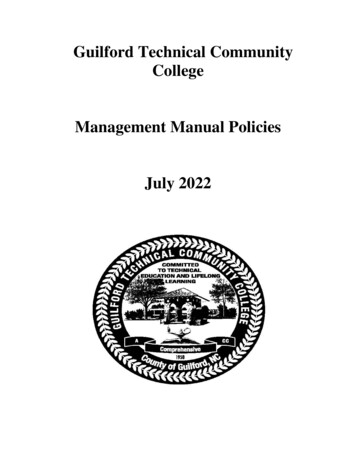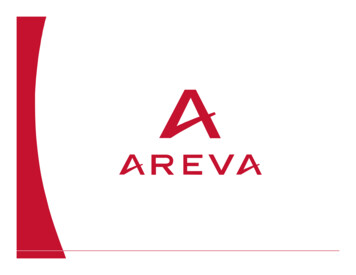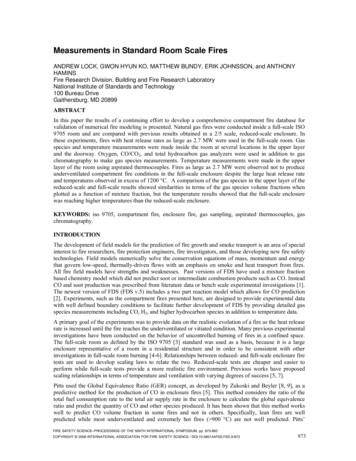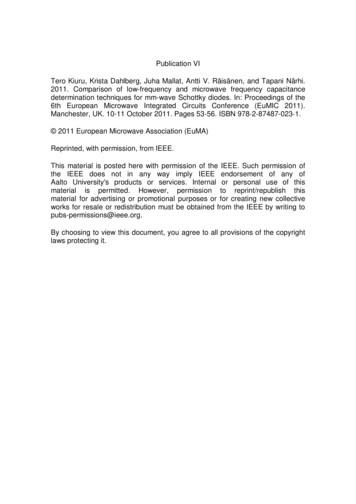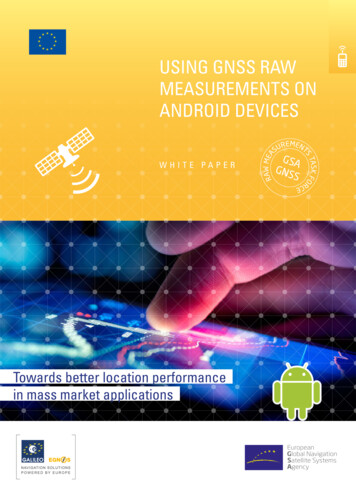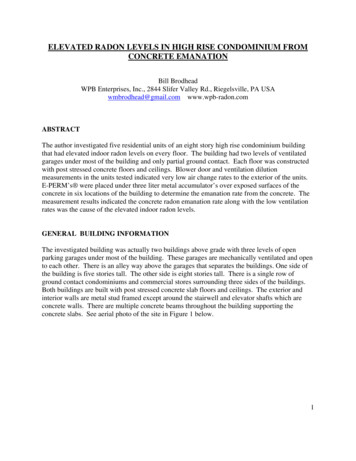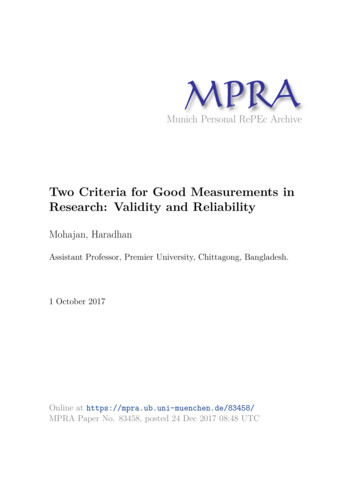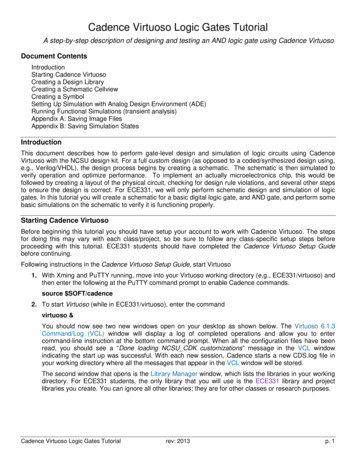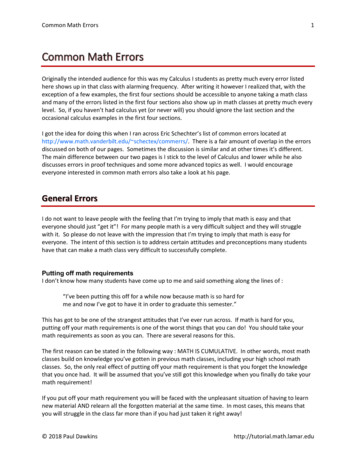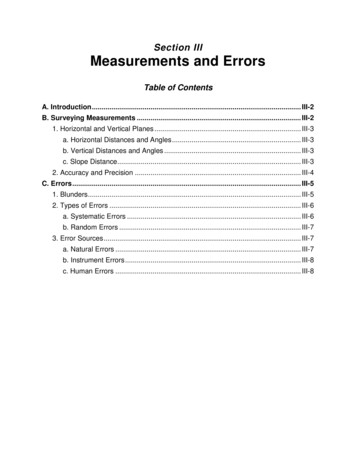
Transcription
Section IIIMeasurements and ErrorsTable of ContentsA. Introduction . III-2B. Surveying Measurements . III-21. Horizontal and Vertical Planes . III-3a. Horizontal Distances and Angles . III-3b. Vertical Distances and Angles . III-3c. Slope Distance. III-32. Accuracy and Precision . III-4C. Errors . III-51. Blunders . III-52. Types of Errors . III-6a. Systematic Errors . III-6b. Random Errors . III-73. Error Sources . III-7a. Natural Errors . III-7b. Instrument Errors . III-8c. Human Errors . III-8
Measurements and ErrorsIII. Measurements and ErrorsA. IntroductionThe purpose of this section is to discuss the different types of surveying measurements, identifyerror sources, and describe procedures to minimize errors. Using common sense and developingsound surveying practices cannot be over-emphasized. In addition to specific surveyingprocedures, the surveyor will often be required to use their judgment to make importantdecisions affecting the survey.Different types of surveying instruments used or the methods in which they are employed willresult in measurement differences. The defined error tolerances of the survey will usually dictatethe equipment or methodology required to achieve the best possible results. Often, surveysinvolving critical elevations will require the use of a digital level or optical total station over GPSequipment. The field conditions encountered will also influence the survey. For example,excessive heat waves or strong winds may make it nearly impossible to accurately perform someoperations. Refer to Section VIII, Survey Standards, in this manual for specific error tolerancesfor each feature code.B. Surveying MeasurementsMeasuring distances and angles from a known reference are fundamental surveying operations.Through the use of trigonometric calculations, the distance and angle measurements are used toestablish three dimensional (3-D) coordinates for each surveyed point. The coordinates are thenplotted to create planimetric maps and digital terrain models (DTM’s). The five common typesof survey measurements are horizontal distances and angles, vertical distances and angles, andslope distances.Figure III-1. Surveying measurements.III-2Revised May, 2013
Section III1. Horizontal and Vertical PlanesAngles and distances are measured relative to either a horizontal or vertical plane. Thehorizontal plane is a level surface radiating outward from the point of observation and isperpendicular to the vertical axis. The vertical axis (or plumb line) is always parallel to thedirection of gravity. The vertical plane runs in a direction parallel to the vertical axis andperpendicular to the horizontal plane. A vertical plane is established whenever theinstrument rotates along the horizontal plane to face a new direction.a. Horizontal Distances and AnglesA linear measurement on the horizontal plane determines the horizontal distance betweentwo points. However, the true horizontal distance is actually curved like the Earth’ssurface. Due to this curvature, the direction of gravity is different at each point.Subsequently, vertical axes are not parallel to each other. Figure III-2 shows arepresentation of the curved surface and the parallel horizontal distance.Horizontal angles are measured on the horizontal plane and establish the azimuth of eachsurvey measurement. An azimuth is a horizontal angle measured clockwise from adefined reference (typically geodetic north).Horizontal distance and anglemeasurements are then used to calculate the position of a point on the horizontal plane.Figure III-2. Horizontal distance.b. Vertical Distances and AnglesVertical distances are measured along the vertical axis to determine the difference inheight (or elevation) between points. Vertical angles are measured in the vertical planeeither above or below the horizontal plane of the instrument. Zenith angles, used as areference for measuring vertical angles, are defined as 0 directly overhead and 90 at thehorizontal plane.c. Slope DistanceThe slope distance is the shortest distance from the instrument to the target. This distanceis the hypotenuse of the horizontal and vertical distances. The horizontal and verticaldistances can be calculated if the slope distance and vertical angle is known.Revised May, 2013III-3
Measurements and Errors2. Accuracy and PrecisionAccuracy and precision are two different, yet equally important surveying concepts.Accuracy is the degree of conformity of a given measurement with a standard value.Precision is the extent to which a given set of measurements agree with their mean.These concepts are illustrated in Figures III-3 through III-5 with a target shooting example.In Figure III-3, all five shots are closely grouped indicating good precision due to the degreeof repeatability. However the accuracy is poor because the shots are far from the center ofthe target. In Figure III-4, the five shots appear randomly scattered about the targetindicating neither accuracy nor precision. In Figure III-5, all five shots are closely spacedabout the target’s center indicating both precision and accuracy.Figure III-3. Precision without accuracy.Figure III-4. Neither precision nor accuracy.III-4Revised May, 2013
Section IIIFigure III-5. Precision and accuracy.The goal of any survey should be to produce accurate and precise observations. Oftenmeasurements with greater accuracy and precision requirements employ multipleobservations to minimize procedural errors. Refer to Chapter 6 in the Data CollectionManual for proper data collection methods. Each measurement should be reviewed to ensurecompliance with defined survey standards before storing it. Refer to Section VIII, SurveyStandards, in this manual for the horizontal and vertical accuracy required for eachmeasurement. Also located in Section VIII is a discussion of the proper surveyinginstrumentation required to meet the standards.C. ErrorsA discrepancy is defined as the difference between two or more measured values of the samequantity. However, measurements are never exact and there will always be a degree of varianceregardless of the survey instrument or method used. These variances are known as errors andwill need to be reduced or eliminated to maintain specific survey standards.Even when carefully following established surveying procedures, observations may still containerrors. Errors, by definition, are the difference between a measured value and its true value. Thetrue value of a measurement is determined by taking the mean value of a series of repeatedmeasurements. Surveyors must possess skill in instrument operation and knowledge ofsurveying methods to minimize the amount of error in each measurement.1. BlundersA blunder (or gross error) is a significant, unpredictable mistake caused by human error thatoften leads to large discrepancies. Blunders are typically the result of carelessness,miscommunication, fatigue, or poor judgment. Examples of common blunders are: Improperly leveling the surveying instrument. Setting up the instrument or target over the wrong control point.Revised May, 2013III-5
Measurements and Errors Incorrectly entering a control point number in the data collector. Transposing numbers or misplacing the decimal point.All blunders must be found and eliminated prior to submitting a survey for inclusion in theproject mapping. The surveyor must remain alert and constantly examine measurements toeliminate these mistakes. Blunders can be detected and eliminated by reacting to “out-oftolerance” messages by the data collector when they occur. They can also be detected bycarefully examining a plot of the collected survey points while in the office.2. Types of ErrorsThere are two types of errors, systematic and random. It is important for the surveyor tounderstand the difference between the two errors in order to minimize them.a. Systematic ErrorsSystematic errors are caused by the surveying equipment, observation methods, andcertain environmental factors. Under the same measurement conditions, these errors willhave the same magnitude and direction (positive or negative). Because systematic errorsare repetitive and tend to accumulate in a series of measurements, they are also referredto as cumulative errors.Although some systematic errors are difficult to detect, the surveyor must recognize theconditions that cause such errors. The following list includes several examples ofsystematic errors: Using incorrect temperature and/or pressure observations. Not applying curvature and refraction constants. Using incorrect instrument heights and/or target heights. Using an incorrect prism offset. Using an imperfectly adjusted instrument.The effect of these errors can be minimized by: Properly leveling the survey instrument and targets. Balancing foresight and backsight observations. Entering the appropriate environmental correction factors in the data collector. Entering the correct instrument heights, targets heights, and prism offset in the datacollector. Periodically calibrating the surveying equipment.If appropriate corrections are not made, these errors can accumulate and cause significantdiscrepancies between measured values. By keeping equipment in proper working orderand following established surveying procedures, many of the systematic errors can beeliminated.III-6Revised May, 2013
Section IIIb. Random ErrorsRandom (or accidental) errors are not directly related to the conditions or circumstancesof the observation. For a single measurement or a series of measurements, it is the errorremaining after all possible systematic errors and blunders have been eliminated.As the name implies, random errors are unpredictable and are often caused by factorsbeyond the control of the surveyor. Their occurrence, magnitude, and direction (positiveor negative) cannot be predicted. Errors of this type are compensating and tend to at leastpartially cancel themselves mathematically. Because the magnitude is also a matter ofchance they will remain, to some degree, in every measurement.Misclosures (or residuals) are the difference in a measurement or a series ofmeasurements from an established value. Random errors account for the misclosurewhen systematic errors have been corrected and blunders have been removed.Misclosures are computed when adjusting level loops, traverses, and GPS networks.Random errors conform to the laws of probability and are therefore equally distributedthroughout the survey. Because of their random nature, correction factors cannot becomputed and applied as they are with some systematic errors. However, they can beestimated using a procedure based on the laws of probability known as the least-squaresmethod of adjustment. This method computes the most probable adjusted values and theprecision of the survey. The least-squares method may also reveal the presence of largeblunders.3. Error SourcesThere are a variety of factors that can lead to measurement errors. Errors typically arise fromthree sources; natural errors, instrument errors, and human errors.a. Natural ErrorsNatural errors are caused by environmental conditions or significant changes inenvironmental conditions. Wind speed, air temperature, atmospheric pressure, humidity,gravity, earth curvature, and atmospheric refraction are examples of natural error sources.Many of these environmental conditions can be compensated for by applying a correctionfactor to each measurement. Commonly used correction factors are the parts per million(ppm) and curvature and refraction constants.The ppm correction factor is applied to slope distances to minimize the effects ofatmospheric changes. The correction is determined using observed temperature andpressure readings. With each instrument setup, new temperature and pressure readingsshould be taken and the ppm constant revised, if necessary. The curvature and refractionconstant is applied to the vertical distance measurement. The constant corrects for theEarth’s curvature and atmospheric refraction and should be applied to the survey by thedata collector.There are other natural phenomena that can lead to measurement errors. Intense, directsunlight may cause differential expansion of the components of the instrument, resultingin minor errors. This effect can be minimized by operating on cloudy days, times of lowRevised May, 2013III-7
Measurements and Errorssun angles, or using a parasol to shade the instrument. Heat waves can cause distortion inlines of sight near reflective surfaces. The effects of heat waves can be minimized bysurveying in cooler, cloudy periods, taking shorter measurements, or avoidingmeasurements taken over asphalt or concrete in excessively hot weather.b. Instrument ErrorsInstrument errors are caused by imperfectly constructed, adjusted, or calibrated surveyingequipment. Most of these errors can be reduced by properly leveling the instrument,balancing backsight/foresight shots, reducing measurement distances, and observingdirect and reverse positions (double centering).Prolonged storage, exposure to rapid changes in temperature, and jarring duringtransportation may lead to instrument maladjustments. Collimation and other sightingerrors can be determined and compensated for by specific instrument adjustments.Before making instrument adjustments or beginning surveying operations, allow theinstrument to adapt to the ambient temperature before proceeding.Instrument errors can be further minimized by periodically calibrating surveyinginstruments, prisms, rods, and tribrachs. Yearly maintenance agreements are purchasedto ensure that WYDOT surveying instruments are regularly cleaned, calibrated, andadjusted by an authorized technician. Occasionally during these services visits, the datacollector’s operating system (firmware) will be replaced with a more current version.It is equally important that equipment suspected of being out of tolerance is sent to theappropriate service center. The Photogrammetry & Surveys Section should be notifiedprior to sending equipment for unscheduled adjustment, calibration and/or repairs.c. Human ErrorsHuman errors are caused by physical limitations and inconsistent setup and observationhabits of the surveyor. For example, minor errors result from misaligning the telescopecrosshairs on the target or not holding the target rod perfectly plumb. These errors willalways be present to some degree in every observation. However, by followingestablished setup and collection procedures, many potential errors can be minimized.Because any survey is only as accurate as the instrument/target setup; a secure, leveltripod is paramount. A tripod should always be used to stabilize the backsight targetwhen placing it over a control point. When positioning the tripod, firmly press the tripodfeet into the ground. Place the tripod legs in a position that will reduce the amount ofwalking near the instrument. Minimizing movement around the tripod will reduce thechances of bumping it. In windy conditions, it may be necessary to place sandbags on thefeet of the tripod to ensure stability. When setting up on steep slopes, position two tripodlegs on the downhill side. Periodically check the optical plummet to verify that theinstrument is still centered over the point. Periodically check the level bubble to ensurethat the instrument is still on a horizontal plane. The level bubble should hold oneposition when the instrument is smoothly rotated through a complete revolution.III-8Revised May, 2013
Section IIIWhen taking an observation with an optical instrument, the center of the target shouldcoincide with the center of the reticle (or crosshair). To obtain accurate results,consistently sight the telescope to the same part of the target. Turn the ocular (or eyepiece) until the reticle is clearly focused. Then adjust the focusing knob until the target isclearly defined within the field of view. When the observer’s eye moves behind theocular, the target and reticle should not be displaced with respect to one another.Revised May, 2013III-9
Systematic errors are caused by the surveying equipment, observation methods, and certain environmental factors. Under the same measurement conditions, these errors will have the same magnitude and direction (positive or negative). Because systematic errors are repetitive and tend to accumulate in a series of measurements, they are also .

